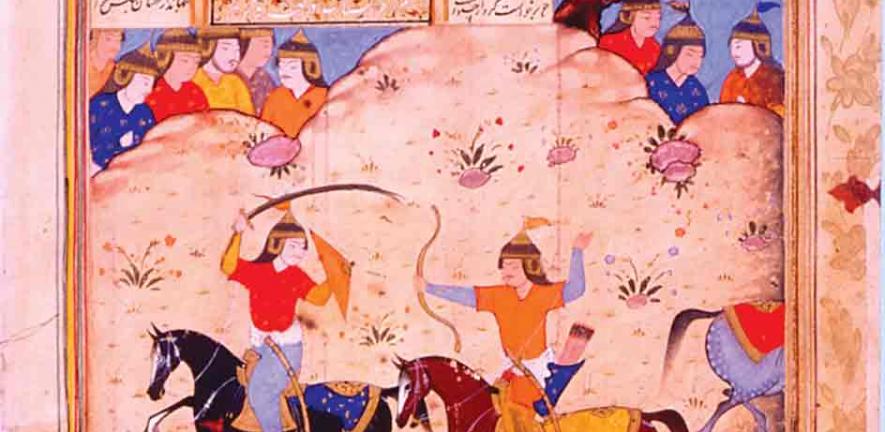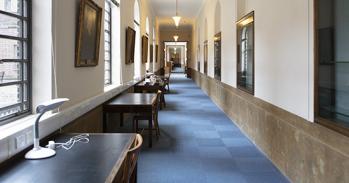
The Shahnama Project is building a powerful online resource that will stimulate research and interest in Persian cultural history.
The Shahnama Project is building a powerful online resource that will stimulate research and interest in Persian cultural history.
Thereafter, seeing sections of the manuscripts side by side and comparing them over time, one can explore the context in which they were made and why they were commissioned.
Dr Charles Melville
Almost 1000 years ago, the Persian poet Firdausi created an epic poem of such unparalleled sweep and power that, after his death in 1020, it continued to live on as a seminal expression of Iranian art, literature and history. The Shahnama (Book of Kings) is the longest poem ever written by a single author and narrates the history of Iran from the first King until the Arab invasions in the early 7th century AD.
The story goes that the sum of money Firdausi was paid by the Sultan for his work of 35 years was so pitiful that he gave it to an attendant at the baths and left the country. Little did he know that, for the next 800 years, his epic tale would be fêted by successive Persian rulers and aristocracy, whose scribes would fashion precious copies and illustrate them using the finest materials – lapis lazuli, gold, ultramarine. Many of these manuscripts survived, became scattered throughout the world and have now been brought together in an online environment by the Shahnama Project at the University of Cambridge.
Dr Charles Melville, from the Faculty of Asian and Middle Eastern Studies, was awarded a five-year grant from the AHRB in 1999 to photograph, catalogue and produce an electronic corpus of the thousands of paintings in the versions of the Shahnama still existing worldwide. A second stage commenced in 2006, with the award of a three-year grant from the AHRC’s Resource Enhancement Scheme to Dr Melville and John Norman of the Cambridge Centre for Applied Research in Educational Technologies (CARET) to develop the Shahnama Project website.
Thanks to the technological expertise and digital know-how provided by CARET, international researchers are able to use this uniquely interactive online resource to gather together a global record of extant Shahnama manuscripts. Visitors are already building their own workspaces for teaching and research, and will be able to use the site to engage in research dialogue with other users. With the addition of a sophisticated behind-the-scenes approvals process, the website will ultimately even allow visitors to correct the database directly. ‘Although it has been vitally important to collate and preserve these images digitally, the result is much more than a catalogue,’ said John Norman, Director of CARET. ‘It is a new type of research tool.’
One of the many fascinating aspects of the research is tracing the ‘transmission history’ of the texts and their illustrations. The oldest surviving copy of the poem dates from 200 years after Firdausi’s death. ‘Thereafter, seeing sections of the manuscripts side by side and comparing them over time, one can explore the context in which they were made and why they were commissioned,’ said Dr Melville.
By the end of the project, it is hoped that the corpus will include 10,000 images, representing about 70% of the surviving manuscripts. ‘My main aim was to stimulate and promote research in Persian history and culture. With this funding, we have had a fantastic opportunity to encapsulate a key element of this and to make it accessible for all to use,’ said Dr Melville.
For more information, please contact Dr Charles Melville (cpm1000@cam.ac.uk) or John Norman (john@caret.cam.ac.uk).
Arts and Humanities Research Council
The Arts and Humanities Research Council (AHRC) supports research within a wide subject domain, from traditional subjects such as history, modern languages and English literature, through to the creative and performing arts.
Established in April 2005 from the Arts and Humanities Research Board (AHRB), the AHRC has an annual budget of around £90 million to fund research and postgraduate study, as well as museums and galleries associated with higher education establishments. In 2006–2007, the value of awarded grants to the University of Cambridge was £4 million.
The AHRC recognises not only the importance of sustaining the arts and humanities research base, but also of ensuring that the knowledge and understanding it generates is widely disseminated. The two Cambridge projects highlighted here – the Shahnama Project and Accessing Virtual Egypt – address this strategic priority in different ways. Indeed, the Council has established itself as a leading authority on research-based knowledge transfer (KT), with several new initiatives (including the KT Fellowship) launched specifically for the AHRC research community. Because the AHRC’s definition of KT is broad and flexible in implementation, its impact has extended to key societal and economic challenges.
Several new strategic initiatives have been planned for 2007–2008. In 2007, the AHRC launched a joint £5m programme on Religion and Society with the Economic and Social Research Council (ESRC) and a £5.5 million programme entitled Beyond Text: Performances, Sounds, Images, Objects. In 2008, work will begin with the Engineering and Physical Sciences Research Council (EPSRC) on a Science and Heritage programme.
Alongside research grant activities, strategic programmes and KT, the AHRC is keen to highlight another priority: the support of postgraduate and early career researchers to protect the long-term sustainability and health of the UK’s arts and humanities research. A recent survey showed that 74% of AHRC award holders go on to pursue academic and research careers, with the majority of others pursuing careers in creative and cultural sectors, non-profit organisations and public services.
This work is licensed under a Creative Commons Licence. If you use this content on your site please link back to this page.





